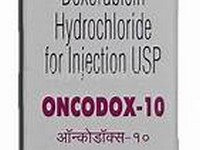doxorubicin hydrochloride
CLINICAL USE
Antineoplastic agent:Acute leukaemias Lymphomas Sarcomas Various solid tumours
DOSE IN NORMAL RENAL FUNCTION
Varies according to local protocol
PHARMACOKINETICS
DOSE IN RENAL IMPAIRMENT
GFR (mL/MIN)
DOSE IN PATIENTS UNDERGOING RENAL REPLACEMENT THERAPIES
IMPORTANT DRUG INTERACTIONS
Potentially hazardous interactions with other drugs
ADMINISTRATION
Reconstition
Reconstitute with water for injection or sodium chloride 0.9%, 10 mg in 5 mL, 50 mg in 25 mL
Route
IV, intra-arterial, intravesical (bladder instillation)
Rate of Administration
Via the tubing of a fast running intravenous infusion of sodium chloride 0.9% or glucose 5%3–5 minutes for the injection 24 hours for continuous infusion
Comments
For bladder instillation, concentration of doxorubicin in bladder should be 50 mg per 50 mL. To avoid undue dilution in urine, the patient should be instructed not to drink any fluid in the 12 hours prior to instillation. This should limit urine production to approximately 50 mL per hour
OTHER INFORMATION
A cumulative dose of 450–550 mg/m 2 should only be exceeded with extreme caution. Above this level, the risk of irreversible congestive cardiac failure increases greatly. Patients with impaired hepatic function have prolonged and elevated plasma concentrations of both the drug and its metabolites. Dose reduction is requiredLiposomal preparations available: up to 90 mg in 250 mL glucose 5%; if greater than 90 mg dilute in 500 mL glucose 5%Mainly metabolised in the liver. Rapidly cleared from plasma and slowly excreted in the urine and bile (50% of drug recoverable in the bile or faeces in 7 days)
